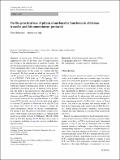| dc.contributor.author | Rührmair, Ulrich | |
| dc.contributor.author | van Dijk, Marten | |
| dc.date.accessioned | 2016-08-25T18:02:24Z | |
| dc.date.available | 2016-08-25T18:02:24Z | |
| dc.date.issued | 2013-03 | |
| dc.date.submitted | 2012-11 | |
| dc.identifier.issn | 2190-8508 | |
| dc.identifier.issn | 2190-8516 | |
| dc.identifier.uri | http://hdl.handle.net/1721.1/103985 | |
| dc.description.abstract | In recent years, PUF-based schemes have been suggested not only for the basic tasks of tamper-sensitive key storage or the identification of hardware systems, but also for more complex protocols like oblivious transfer (OT) or bit commitment (BC), both of which possess broad and diverse applications. In this paper, we continue this line of research. We first present an attack on two recent OT and BC protocols which have been introduced by Brzuska et al. (CRYPTO, LNCS 6841, pp 51–70, Springer 2011). The attack quadratically reduces the number of CRPs which malicious players must read out to cheat, and fully operates within the original communication model of Brzuska et al. (CRYPTO, LNCS 6841, pp 51–70, Springer 2011). In practice, this leads to insecure protocols when electrical PUFs with a medium challenge-length are used (e.g., 64 bits), or whenever optical PUFs are employed. These two PUF types are currently among the most popular designs of so-called Strong PUFs. Secondly, we show that the same attack applies to a recent OT protocol of Ostrovsky et al. (IACR Cryptol. ePrint Arch. 2012:143, 2012), leading to exactly the same consequences. Finally, we discuss countermeasures. We present a new OT protocol with better security properties, which utilizes interactive hashing as a substep and is based on an earlier protocol by Rührmair (TRUST, LNCS 6101, pp 430–440, Springer 2010). We then closely analyze its properties, including its security, security amplification, and practicality. | en_US |
| dc.publisher | Springer-Verlag | en_US |
| dc.relation.isversionof | http://dx.doi.org/10.1007/s13389-013-0052-8 | en_US |
| dc.rights | Article is made available in accordance with the publisher's policy and may be subject to US copyright law. Please refer to the publisher's site for terms of use. | en_US |
| dc.source | Springer-Verlag | en_US |
| dc.title | On the practical use of physical unclonable functions in oblivious transfer and bit commitment protocols | en_US |
| dc.type | Article | en_US |
| dc.identifier.citation | Rührmair, Ulrich, and Marten van Dijk. “On the Practical Use of Physical Unclonable Functions in Oblivious Transfer and Bit Commitment Protocols.” J Cryptogr Eng 3, no. 1 (March 26, 2013): 17–28. | en_US |
| dc.contributor.department | Massachusetts Institute of Technology. Computer Science and Artificial Intelligence Laboratory | en_US |
| dc.contributor.mitauthor | van Dijk, Marten | en_US |
| dc.relation.journal | Journal of Cryptographic Engineering | en_US |
| dc.eprint.version | Author's final manuscript | en_US |
| dc.type.uri | http://purl.org/eprint/type/JournalArticle | en_US |
| eprint.status | http://purl.org/eprint/status/PeerReviewed | en_US |
| dc.date.updated | 2016-08-18T15:40:04Z | |
| dc.language.rfc3066 | en | |
| dc.rights.holder | Springer-Verlag Berlin Heidelberg | |
| dspace.orderedauthors | Rührmair, Ulrich; van Dijk, Marten | en_US |
| dspace.embargo.terms | N | en |
| dc.identifier.orcid | https://orcid.org/0000-0002-1224-0314 | |
| mit.license | PUBLISHER_POLICY | en_US |
